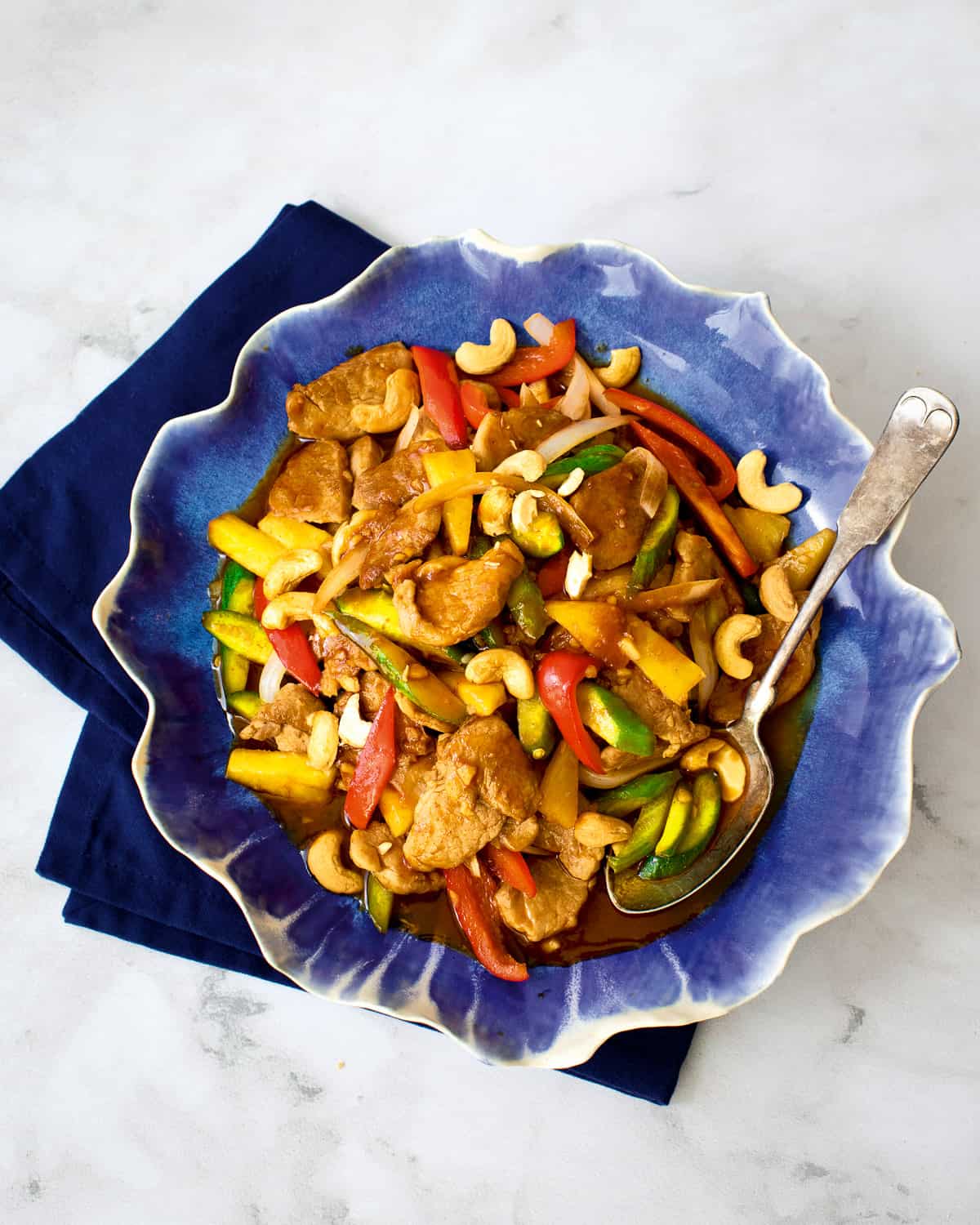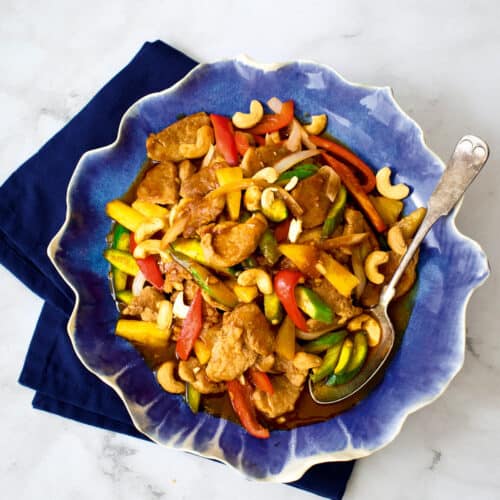This recipe is an excerpt from my cookbook Sabai: 100 Simple Thai Recipes for Any Day of the Week
When you hear “sweet and sour pork,” you probably think of the popular takeout from Chinese restaurants with breaded deep fried pork in a thick, sweet sauce. Rest assured that this Thai version is much lighter, healthier, no deep frying required, and IMHO is even more delicious!
This Thai-style sweet and sour pork recipe is loaded with veggies, with a light sauce that is the perfect balance of sweet, sour, and just a touch of spice. It’ll change how you look at what a sweet and sour dish can be AND it can be done in 35 minutes!

Both! Sweet and sour pork is indeed a dish of Chinese origins, but in Thailand, many of our dishes have their roots in Chinese cuisine, such as cashew chicken and pad see ew.
See more: Khao Soi: Thai Curry Noodle Soup
This is because a large number of Chinese immigrants have come and settled in Thailand, bringing with them their delicious food. But Chinese food in Thailand has been integrated and modified to satisfy the Thai palate, resulting in something totally unique.
But if you’re thinking of the sweet and sour pork that’s iconic of Chinese American takeout, the Thai version is quite different. The meat isn’t fried, and there is an abundance of veggies. The Thai sweet and sour sauce is also not thickened so it’s quite light, and the flavour is less sweet compared to the typical takeout version.
Sweet and sour pork uses simple ingredients. As you can see in the video I didn’t even have to go to an Asian grocery store for the ingredients! When you’re ready to cook, see the full recipe card for amounts and prep instructions.
- Pork tenderloin is my preferred cut for this because it is tender yet lean. Pork shoulder will also work but do slice it more thinly as it can be a bit chewy if too thick. Pork chops are not ideal, but if you do use it, be extra careful not to overcook it as it easily becomes tough and dry.
- Soy sauce
- Neutral oil such as vegetable oil
- Garlic
- Onion
- Mini cucumber. Thai cucumber are quite small so smaller cucumbers such as Japanese or Persian ones work. If not available, English cucumber will also do.
- Fresh pineapple. Fresh is much better than canned pineapple in a savoury application, but no need to cut up a whole pineapple! Just get pre-cut fresh pineapple chunks from the ready-to-eat fruit section at the supermarket.
- Red bell pepper, but green bell peppers would also be lovely.
- Roasted cashews, unsalted preferred but salted will be fine.
- Green onions. Not pictured (optional)
- Jasmine rice for serving
Contents
Homemade Sweet and Sour Sauce
You can make a big batch of this sauce and it will keep in the fridge indefinitely, so it’s ready to go any time for any kind of sweet and sour dishes.
- Brown sugar, light or dark. If you want to use finely chopped palm sugar instead that’s fine too.
- White vinegar, rice vinegar, or apple cider vinegar will also work
- Oyster sauce, see this post for how to choose a good oyster sauce
- Sriracha hot sauce, this amount of sriracha will result in a teeny-tiny bit of spiciness, but the sweetness of this dish really benefits from a little heat and acid to balance. If you’re serving kids and need this to have no heat at all, you can substitute ketchup. I also have a homemade sriracha recipe if you want to DIY.
- Soy sauce
- Toasted sesame oil, the bottle may not say “toasted” but if the colour is dark brown it is the one you need. It should have a very distinct aroma. Don’t get untoasted sesame oil which is light in colour.
Here’s a bird’s eye view of how the dish is done, and when you’re ready to cook, see the recipe card for the detailed instructions. I also recommend watching the video tutorial if this is your first time!
- Remove any silver skin from the pork, then cut the tenderloin in half horizontally. Cut each half into ⅓-inch (8 mm) slices. Marinate the pork with some soy sauce and let it sit until ready to use.
- Make the sweet and sour sauce by combining all the ingredients in a small bowl; stir until the sugar is mostly dissolved.
- In a hot work or a large skillet over high heat, add some vegetable oil and once the pan is very hot spread the pork pieces out into one layer. Sear them without moving until browned on the underside and is about halfway done, 1 to 2 minutes.
- Toss and stir the pork for about 30 seconds just until most of the exterior looks cooked; remove from the pan, leaving the juices behind.
- In the same pan on medium heat,add a little bit more oil if needed, then saute the garlic and onion until the garlic starts to turn golden.
- Turn the heat up to highand add the cucumber, pineapple, bell peppers, and the sauce.
- Toss everything for about 2 minutes or until the veggies are cooked to your liking.
- Add the pork back inand toss for 30 seconds, just until heated through. Be careful not to overcook the pork.
- Turn off the heat and stir in the cashews.
- Serve with fluffy white rice, such as jasmine rice. Enjoy!
Looking to serve this for a dinner party? It’s an excellent choice because there’s so much you can do ahead of time, but the stir frying should be done shortly before serving. Here are 3 things you can do ahead, and if you do all 3, the dish will be done in 5 minutes.
- Mix the sauce ahead of time and it will last indefinitely in the fridge. I recommend doing this in bulk so you’ll have multiple batches of sauce ready to go any time!
- Cut all the vegetables in advance. All of the veggies in this dish are sturdy and will last in the fridge for at least a few days in an airtight container.
- The pork can even be cooked in advance! You can sear the pork and then cook it until done. Keep it in the fridge along with all the yummy juices. When you do the final cooking, be sure to add the pork juices back into the pan and give the pork enough time to heat through.
Sweet and sour pork will keep for a few days in the fridge, though the cucumber might lose a bit of crunch. The most significant casualty will be the cashews which will absorb moisture and become soft. I really don’t like softened cashews, so I always throw in some extra fresh cashews after reheating the leftovers.
I don’t eat pork, can I use this recipe to make sweet and sour chicken instead?
Absolutely! Chicken works really well as a substitute here; I prefer dark meat, but if you like your white meat, go for it. There’s nothing else in the recipe that you will need to change.
How can this recipe be made vegan?
You can substitute firm tofu for the pork, and you can use my sweet and sour tofu recipe as a guide. For the oyster sauce, substitute vegetarian oyster sauce (also known as vegetarian stir fry sauce) or 2 teaspoon of Maggi or Golden Mountain Seasoning.
Why is your sweet and sour sauce not thickened?
Most Chinese sweet and sour recipes you’ve come across likely requires thickening the sauce with a cornstarch slurry. Thai stir fries, however, are never thickened. So the sauce is supposed to be light, perfect for moistening the rice!

Sweet and Sour Pork Recipe (No Fry)
Equipment
-
A wok or a large skillet
Ingredients
- 12ouncespork tenderloin
- 2teaspoonssoy sauce
- 2tablespoonsneutral oil
- 5clovesgarlic, chopped
- ½medium onion, cut in ⅓-inch (8 mm) strips
- 1½cupsMini or English cucumber, halved lengthwise and sliced
- 1cupfresh pineapple, bite-sized pieces, (see note)
- 1cupbell pepper, any colour, julienned
- ½cupunsalted roasted cashews, plus extra for garnish
- 1 to 2green onions, chopped (optional)
- Jasmine rice, for serving
SWEET & SOUR SAUCE
- 2tablespoonsbrown sugar, packed
- 2tablespoonswhite vinegar
- 2tablespoonsoyster sauce
- 2tablespoonssriracha
- 1tablespoonsoy sauce
- 2teaspoonstoasted sesame oil
Notes
Instructions
-
Remove any silver skin from the pork, then cut the tenderloin in half horizontally. Cut each half into ⅓-inch (8 mm) slices and place them in a small mixing bowl. Add the 2 teaspoons (10 ml) soy sauce and mix well to coat.12 ounces pork tenderloin, 2 teaspoons soy sauce
-
Make the sweet and sour sauce by combining all the ingredients in a small bowl; stir until the sugar is mostly dissolved.2 tablespoons brown sugar, 2 tablespoons white vinegar, 2 tablespoons oyster sauce, 2 tablespoons sriracha, 1 tablespoon soy sauce, 2 teaspoons toasted sesame oil
-
Place a wok on high heat and add the oil. Once it’s very hot, add the pork and spread it out into one layer (you may need to do this in batches ). Let the pork cook without moving it until browned on the underside, 1 to 2 minutes. Toss and stir for about 30 seconds, or just until most of the exterior looks cooked; don’t worry about the inside being done at this point. Place the pork in a bowl, leaving behind any oil and juices.2 tablespoons neutral oil
-
In the same wok on medium heat, add a little more oil if needed, then add the garlic and onions and stir until the garlic starts to turn golden.5 cloves garlic, ½ medium onion
-
Turn the heat up to high and add the cucumber, pineapple, bell peppers, and sauce. Toss for about 2 minutes.1½ cups Mini or English cucumber, 1 cup fresh pineapple, 1 cup bell pepper, any colour
-
Add the pork back in and stir for 30 seconds, just until heated through. Be careful not to overcook the pork, as lean meat like tenderloin becomes dry quickly. (Pork is perfectly safe to eat medium-cooked to a minimum internal temperature of 145°F/63°C ). Turn off the heat and stir in the cashews and green onions.½ cup unsalted roasted cashews, 1 to 2 green onions
-
Plate and top with more cashews and green onions, if you like. Serve with jasmine rice.Jasmine rice
































